Pavlova with Mascarpone Whipped Cream
Pavlova is a cloud-like meringue cake with a delicate, crisp crust, topped with mascarpone whipped cream and fruit for a heavenly dessert! Top it with my favorite mascarpone whipped cream, sugared cranberries, and fresh fruit for a heavenly dessert!
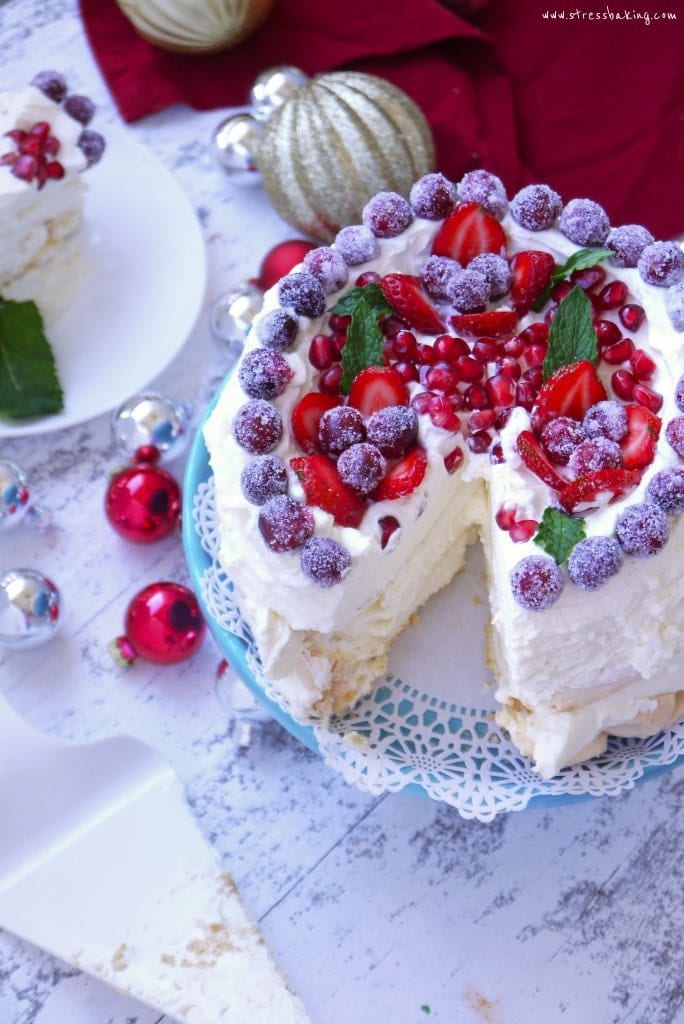
G'day, mates! I've decently discovered that I have an enormous amount of traffic from Australia, and I'm… confused. Don't get me wrong – I'm thrilled! But I can't figure out why that would be.
Does “stress baking” mean something special down under? Am I some sort of Aussie celebrity and I just don't know about it?
Regardless of the reason behind it, I'm happy to have you all here! And for that reason, I wanted to make something inspired by an Australian dish: Pavlova.
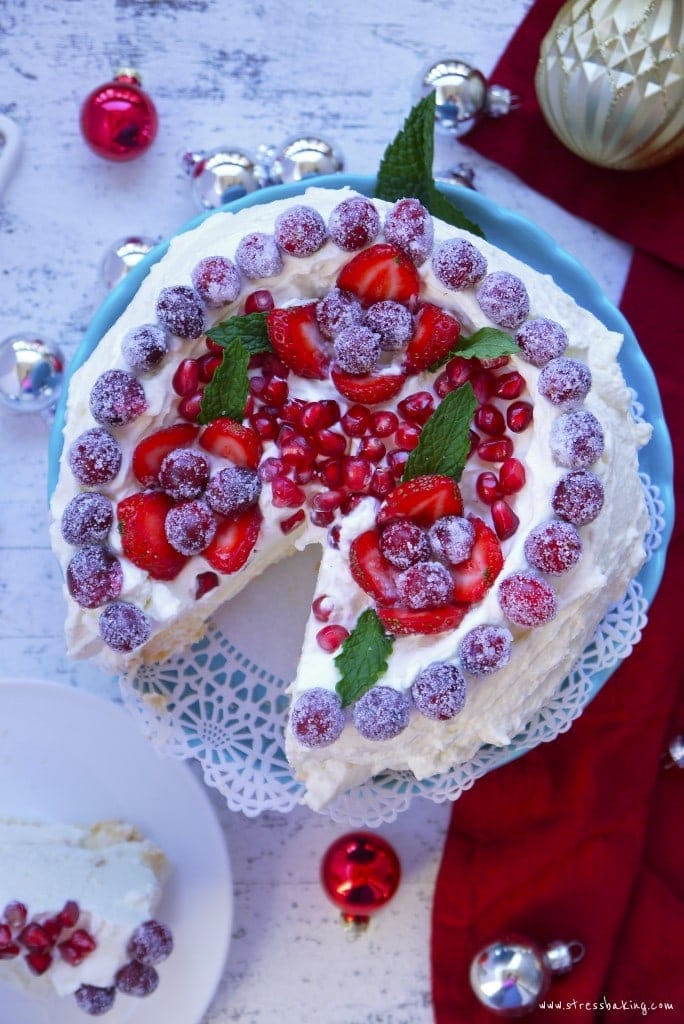
What is pavlova?
I'd seen them before in pictures, but didn't know much about them. I did a little research about the namesake, the country of origin (as I understand it, it's a battle of he said/she said between Australia and New Zealand), and how it's normally prepared.
I've made plenty of meringues before, so I knew I could handle it since I basically needed to make a REALLY big meringue.
Tips about the eggs
Older eggs are better. Generally speaking, older egg whites are thinner and whip more easily to create more volume than thicker fresh egg whites.
Separate your eggs while they’re still cold. You want the egg whites to be room temperature before you start working with them, but it’s much easier to separate them when they’re right out of the fridge.

An easy way to separate egg yolks and whites
Speaking of eggs, my go-to way of separating eggs it to simply use one hand.
- After thoroughly washing your hands, crack the egg against the counter (and not the edge of a bowl since that can potentially puncture the yolk) and into a bowl.
- Lower your fingers underneath the yolk and gently lift it out of the bowl, letting the whites drip down through my fingers and back into the bowl. You may need to open your middle fingers slightly to allow the whites more room to separate, but be careful not to let the yolk itself slip through.
- Transfer the yolk to a separate bowl, and then repeat the same process for the rest of your eggs!
Save the egg yolks for another recipe and store them in covered in the fridge. Sounds like a good excuse to make a key lime pie, fruit tart, or some eggnog!
And remember – even the smallest amount of yolk can ruin things, so make sure you’re only working with 100% egg whites.
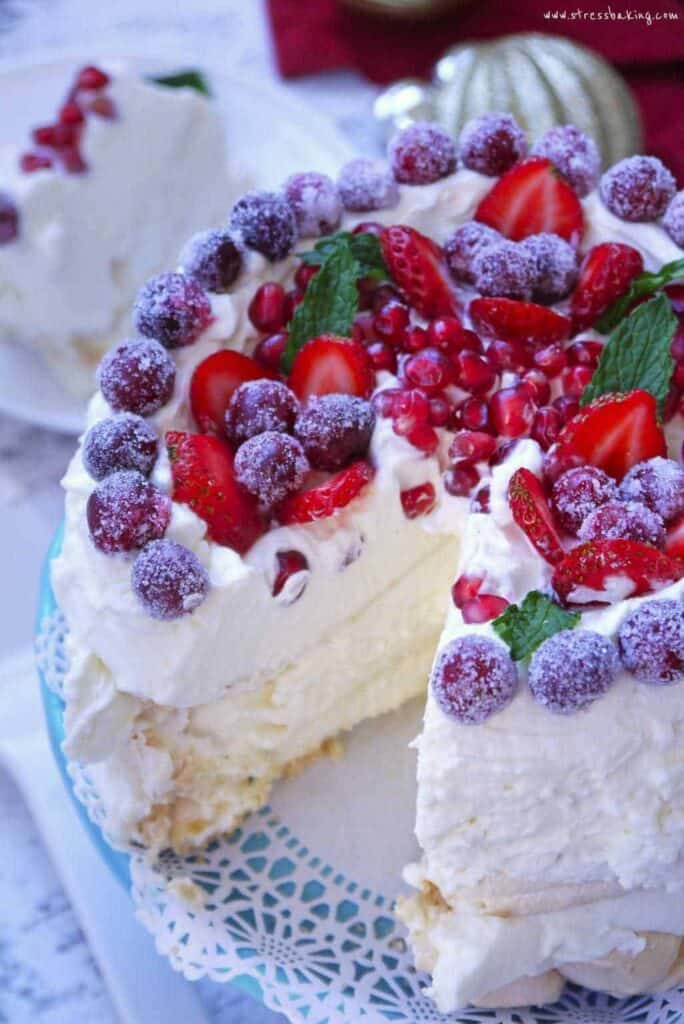
8 tips for making the best pavlova
1. Make sure everything is clean. You have to be sure to use a clean and dry bowl, preferably glass or metal. Even the tiniest amount of moisture, dirt or grease can prevent your pavlova from reaching it’s fullest and fluffiest potential.
Pretend a health inspector is coming by, or your pickiest and most intrusive relative that comments on everything when they come to visit. Whatever gets you in the right mindset.
2. Weather is a factor. I know, it’s not like you’re making these outside! But if it’s a stormy or otherwise humid day, it can affect your results. That’s because meringue doesn’t like more moisture than it can handle. So if you live in the middle of the rain forest without air conditioning, you might have a hard time getting proper results.
3. Stand mixer (aff link) > hand mixer (aff link) > handheld whisk. Using a stand mixer (aff link) will give your arm a rest and be the most uniform, but a hand mixer (aff link) will allow you to most thoroughly incorporate any rogue sugar crystals on the sides of the bowl.
You could also use a whisk and some serious arm muscles, but I don’t have that kind of will – power to you if you do!
4. Beat to soft peaks before adding sugar, then to stiff peaks with the sugar. You want to combine the egg whites, cream of tartar and salt to frothy, soft peaks first. That means when you lift the mixer whisk out of the mixture, the tops flop over.
Then you’ll slowly add your sugar and peak everything to stiff peaks.
5. Add your sugar slowly. And by slowly, I mean in speed and in small amounts. I typically add it 1 teaspoon at a time, mixing after each addition until the sugar has completely dissolved before adding more.
It takes more time, but yields the most consistent results.
6. Be patient! To get to stiff peaks, it may take several minutes, and you just gotta hang in there. You want the resulting meringue to be glossy with stiff peaks. That means when you pull the whisk out of the mixture, the tops stand up on their own.
7. Prepare and bake your meringue right away. If it sits out for too long, it will deflate and “weep”.
8. Bake low and slow, and leave that oven door closed! You want to gradually reduce the heat after baking to prevent them from cracking due to the temperature difference. To give our pavlova the best chance, we bake at 275°F for an hour, and then turn the oven off. This allows it to slowly come to a lower temperature that’s closer to room temperature. Just keep the oven door closed and let it hang out for another hour.
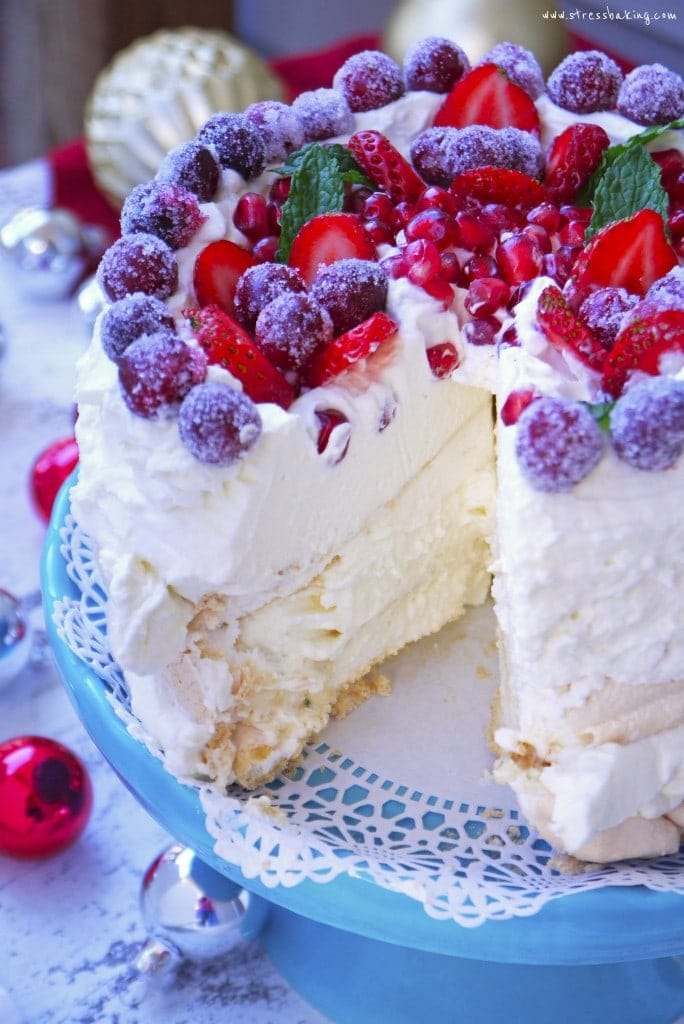
Pavlova toppings
I'm told a traditional way of serving pavlova is with whipped cream and fruit, so that's exactly what I did! I may have gotten a little carried away with the amount of whipped cream, but you all know how I feel about my mascarpone whipped cream. There can never be enough.
For mine, I also used a combination of fresh fruit, sugared cranberries and mint leaves to infuse it with a little Christmas cheer.
I love it. I really do. It's light and fluffy, with just enough of a crispness on the outside of the pavlova to prevent it from feeling like a pile of mush. I like to make mine with a drop of vanilla extract, and I purposely keep it in the oven a little bit longer than most people to give the outside a little bit of color.
I know that's not how you're supposed to do it, but I'm a rebel. I don't play by anyone's rule but my own.
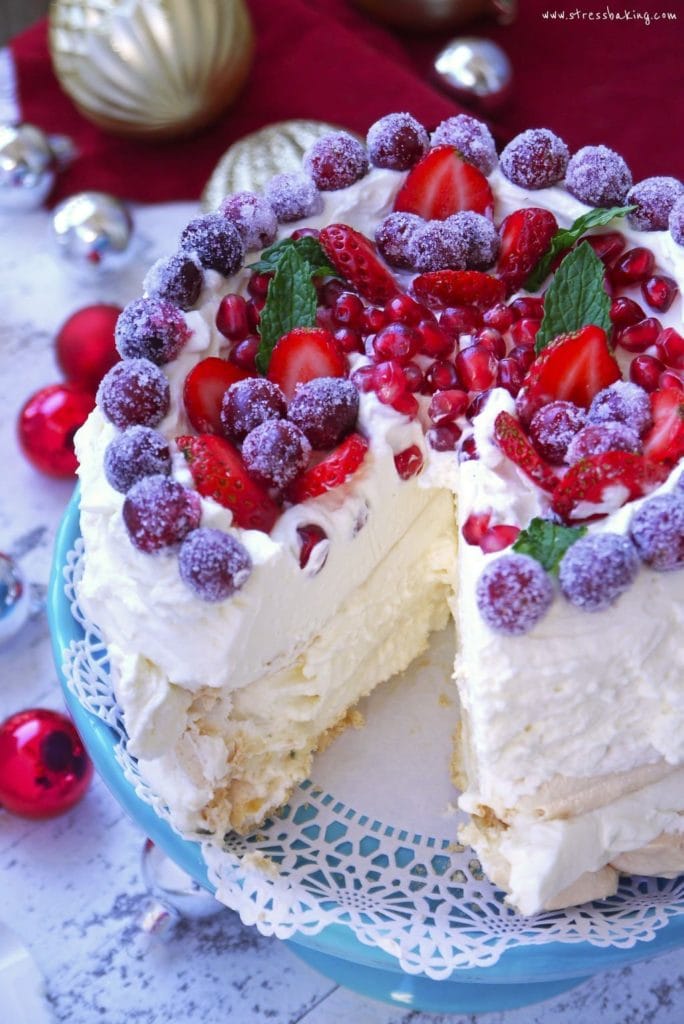
How to store pavlova
What I've learned is that when storing a pavlova, the most important thing is to keep it away from heat and moisture.
So the meringue is completely cooled, you want to keep each layer stored in an airtight container someplace cool and dry – but not the fridge. Even better, wrap each one in plastic wrap, and then inside the airtight containers.
Leftovers of the assembled pavlova should be stored in the fridge the same way, but will be best eaten within 1 day as it will lose it's crispness and gain moisture from the whipped cream.
Leaving a comment and star rating is a great (and free) way to support Stress Baking! ❤️ After you've made this recipe, please consider clicking on the stars below and leaving a comment to share your experience!
Pavlova with Mascarpone Whipped Cream
Equipment
Ingredients
Pavlova
- 6 egg whites
- 1 ½ teaspoons cream of tartar
- ½ teaspoon salt
- 1 ¼ cups granulated sugar
Mascarpone Whipped Cream
- See recipe here, amount depends on size of pavlova rounds – see instructions below
- Sugared cranberries and/or fresh fruit for topping
Instructions
Pavlova
- Preheat oven to 275° F.
- Tear off a sheet of parchment paper to a size that will fill a baking sheet. Take a small bowl or plate, flip it over, and trace it on left side of the parchment paper with a pen or pencil. Do the same on the right side. Flip the sheet over and line a baking sheet with the parchment paper – you want to be able to see the tracing through the paper. Set aside.
- In a large stand mixer (aff link), beat the egg whites until they're frothy and turn white.6 egg whites
- Add cream of tarter and salt and beat to combine.1 1/2 teaspoons (1 ½ teaspoons) cream of tartar1/2 teaspoon (½ teaspoon) salt
- Add sugar, a little at a time, until combined. Beat on high speed until it forms stiff peaks.1 1/4 cups (250 g) granulated sugar
- Using a piping bag with a large opening (or just a spoon/spatula if you're comfortable), pipe egg white mixture onto each circle evenly. Think of it as topping a really large cupcake! Depending on the size of each of your circles, you may have leftover mixture – you can use that to make some smaller pavlovas on a separate baking sheet (bake them at a separate time).
- On a low rack in the oven, bake for an hour. Turn off the heat, crack open then oven door, and let the pavlova cool slowly (leaving it in the oven). Once cooled, remove and let set at room temperature in a cool dry place while you prepare your toppings.
Mascarpone Whipped Cream
- If your pavlova rounds are larger than 10", make a double batch of my (or if you just really, really love whipped cream like I do).
- Carefully remove pavlova from parchment paper and place one of the rounds on a serving platter/cake stand. Top with whipped cream, then add the second round. Top with whipped cream, fresh fruit and/or sugared cranberries. Serve and enjoy!
Nutrition Facts
Nutrition Disclaimer
The provided nutrition information is generated by an automatic API and does not take variations across specific brands into account. This information is provided as a general guideline and should not be treated as official calculations. Learn more here.



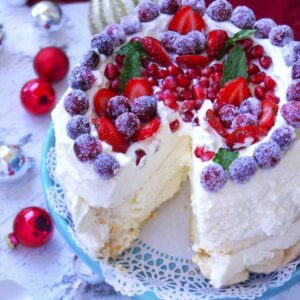
It took me a while to get good at making pavlovas, but it was worth it because this was a great spring dessert for easter
It can certainly take some practice to get it right!